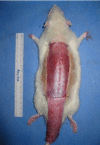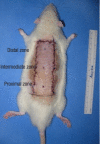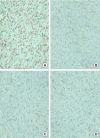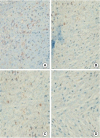Effect of fractional ablative carbon dioxide laser with lidocaine spray on skin flap survival in rats
- PMID: 31462015
- PMCID: PMC6715546
- DOI: 10.7181/acfs.2019.00381
Effect of fractional ablative carbon dioxide laser with lidocaine spray on skin flap survival in rats
Abstract
Background: Lidocaine spray is a local anesthetic that improves random-pattern skin flap survival. The fractional ablative carbon dioxide laser (FxCL) produces vertical microchannels that delivers topically applied drugs to the skin. In this study, we hypothesized that FxCL therapy would enhance the lidocaine effect to improve random-pattern skin flap survival in rats.
Methods: McFarlane random-pattern skin flaps were elevated in 48 rats, which were divided into four groups according to treatment: FxCL+lidocaine, FxCL, lidocaine, and nontreatment (control). On postoperative day 7, necrotic flap areas, the number of capillary vessels, and neutrophil count were evaluated. Anti-rat vascular endothelial growth factor (VEGF) and CD31 antibody activity were also evaluated by immunohistochemical staining.
Results: Flap survival rate was 53.41%± 5.43%, 58.16%± 4.80%, 57.08%± 5.91%, and 69.08%±3.20% in the control, lidocaine, FxCL, and FxCL+lidocaine groups, respectively. Mean neutrophil count in the intermediate zone excluding the necrotic tissue was 41.70± 8.40, 35.43± 6.41, 37.23±7.15, and 27.20± 4.24 cells/field in the control, lidocaine, FxCL, and FxCL+lidocaine groups, respectively. Anti-rat VEGF and CD31 antibody activity were the highest in the FxCL+lidocaine group.
Conclusion: FxCL with lidocaine had a positive effect on random-pattern skin flap survival in rats. Thus, FxCL with lidocaine spray should be considered as a new treatment option to improve flap viability.
Keywords: Lasers, gas; Lidocaine; Rats.
Conflict of interest statement
No potential conflict of interest relevant to this article was reported.
Figures









Similar articles
-
Effects of lidocaine on random skin flap survival in rats.Dermatol Surg. 2015 Jan;41(1):53-8. doi: 10.1097/DSS.0000000000000241. Dermatol Surg. 2015. PMID: 25521105
-
[Effects and related mechanism of bivalirudin on the survival of random skin flap on the back of rat].Zhonghua Shao Shang Za Zhi. 2017 Apr 20;33(4):228-232. doi: 10.3760/cma.j.issn.1009-2587.2017.04.008. Zhonghua Shao Shang Za Zhi. 2017. PMID: 28427136 Chinese.
-
Enhancement of dorsal random-pattern skin flap survival in rats with topical lidocaine and prilocaine (EMLA): enhancement of flap survival by EMLA.J Surg Res. 2005 Mar;124(1):134-8. doi: 10.1016/j.jss.2004.08.035. J Surg Res. 2005. PMID: 15734491
-
The effects of polydeoxyribonucleotide on the survival of random pattern skin flaps in rats.Arch Plast Surg. 2013 May;40(3):181-6. doi: 10.5999/aps.2013.40.3.181. Epub 2013 May 16. Arch Plast Surg. 2013. PMID: 23730590 Free PMC article.
-
Enhancement of epigastric skin flap survival by adenovirus-mediated VEGF gene therapy.Plast Reconstr Surg. 2002 May;109(6):1986-93. doi: 10.1097/00006534-200205000-00031. Plast Reconstr Surg. 2002. PMID: 11994603
References
-
- Yang M, Sheng L, Li H, Weng R, Li QF. Improvement of the skin flap survival with the bone marrow-derived mononuclear cells transplantation in a rat model. Microsurgery. 2010;30:275–81. - PubMed
-
- Davis RE, Wachholz JH, Jassir D, Perlyn CA, Agrama MH. Comparison of topical anti-ischemic agents in the salvage of failing random-pattern skin flaps in rats. Arch Facial Plast Surg. 1999;1:27–32. - PubMed
-
- Shalom A, Friedman T, Westreich M. The effect of postoperative aspirin on random pattern flaps in rats. Am Surg. 2007;73:1126–8. - PubMed
-
- Miyawaki T, Jackson IT, Bier UC, Andrus L, Williams F, Bradford M. The effect of capsaicin ointment on skin for the survival of a cutaneous flap. Eur J Plast Surg. 2001;24:28–30.
Grants and funding
LinkOut - more resources
Full Text Sources

